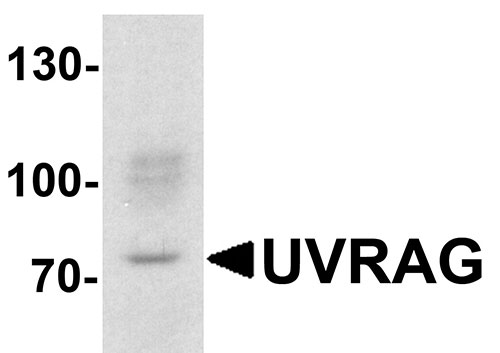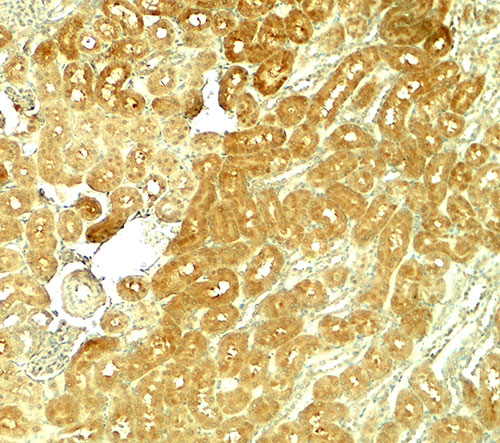SMURF1 Antibody
- SPECIFICATION
- CITATIONS
- PROTOCOLS
- BACKGROUND

Application
| WB, IHC-P, E |
|---|---|
| Primary Accession | Q9HCE7 |
| Other Accession | NP_065162, 31317292 |
| Reactivity | Human, Mouse, Rat |
| Host | Rabbit |
| Clonality | Polyclonal |
| Isotype | IgG |
| Calculated MW | Predicted: 80, 83 kDa Observed: 78 kDa |
| Application Notes | SMURF1 body can be used for detection of SMURF1 by Western blot at 1 - 2 µg/ml. Antibody can also be used for Immunohistochemistry starting at 5 µg/mL. |
| Gene ID | 57154 |
|---|---|
| Target/Specificity | SMURF1; SMURF1 antibody is human, mouse and rat reactive. At least three isoforms of SMURF1 are known to exist this antibody will recognize all three isoforms. SMURF1 is predicted to not cross-react with SMURF2. |
| Reconstitution & Storage | SMURF1 antibody can be stored at 4℃ for three months and -20℃, stable for up to one year. |
| Precautions | SMURF1 Antibody is for research use only and not for use in diagnostic or therapeutic procedures. |
| Name | SMURF1 |
|---|---|
| Synonyms | KIAA1625 |
| Function | E3 ubiquitin-protein ligase that acts as a negative regulator of BMP signaling pathway. Mediates ubiquitination and degradation of SMAD1 and SMAD5, 2 receptor-regulated SMADs specific for the BMP pathway. Promotes ubiquitination and subsequent proteasomal degradation of TRAF family members and RHOA. Promotes ubiquitination and subsequent proteasomal degradation of MAVS (PubMed:23087404). Acts as an antagonist of TGF-beta signaling by ubiquitinating TGFBR1 and targeting it for degradation (PubMed:21791611). Plays a role in dendrite formation by melanocytes (PubMed:23999003). |
| Cellular Location | Cytoplasm. Cell membrane; Peripheral membrane protein; Cytoplasmic side |
| Tissue Location | Expressed in melanocytes (PubMed:23999003). |

Thousands of laboratories across the world have published research that depended on the performance of antibodies from Abcepta to advance their research. Check out links to articles that cite our products in major peer-reviewed journals, organized by research category.
info@abcepta.com, and receive a free "I Love Antibodies" mug.
Provided below are standard protocols that you may find useful for product applications.
Background
SMURF1 (SMAD ubiquitin regulatory factor 1) is a negative regulator of TGF-beta signaling (1). SMURF1 and SMURF2 are members of HECT domain E3 ubiquitin ligase which are involved in the enzymatic reactions of the Ub conjugating pathway (1,2). SMURF1 negatively regulates osteoblast activity and response to bone morphogenesis protein (BMP) through controlling MEKK2 degradation (3). SMURF1 has recently been shown to play a role in breast cancer cell migration and invasion through the downregulation of RhoA (4).
References
Huibregtse JM, Scheffner M, Beaudenon S, et al. A family of proteins structurally and functionally related to the E6-AP ubiquitin-protein ligase. Proc. Natl. Acad. Sci. USA 1995; 92:2563-7.
Hwang YS, Lee HS, Kamata T, et al. The Smurf ubiquitin ligases regulate tissue separation via antagonistic interactions with ephrinB1. Genes Dev. 2013; 27:491-503.
Yamashita M, Ying SX, Zhang G, et al. Ubiquitin ligase Smurf1 controls osteoblast activity and bone homeostasis by targeting MEKK2 for degradation. Cell 2005; 121:101-113.
Kwon A, Lee HL, Woo KM, et al. SMURF1 plays a role in EGF-induced breast cancer cell migration and invasion. Mol. Cells 2013; 36:548-55.
If you have used an Abcepta product and would like to share how it has performed, please click on the "Submit Review" button and provide the requested information. Our staff will examine and post your review and contact you if needed.
If you have any additional inquiries please email technical services at tech@abcepta.com.













 Foundational characteristics of cancer include proliferation, angiogenesis, migration, evasion of apoptosis, and cellular immortality. Find key markers for these cellular processes and antibodies to detect them.
Foundational characteristics of cancer include proliferation, angiogenesis, migration, evasion of apoptosis, and cellular immortality. Find key markers for these cellular processes and antibodies to detect them. The SUMOplot™ Analysis Program predicts and scores sumoylation sites in your protein. SUMOylation is a post-translational modification involved in various cellular processes, such as nuclear-cytosolic transport, transcriptional regulation, apoptosis, protein stability, response to stress, and progression through the cell cycle.
The SUMOplot™ Analysis Program predicts and scores sumoylation sites in your protein. SUMOylation is a post-translational modification involved in various cellular processes, such as nuclear-cytosolic transport, transcriptional regulation, apoptosis, protein stability, response to stress, and progression through the cell cycle. The Autophagy Receptor Motif Plotter predicts and scores autophagy receptor binding sites in your protein. Identifying proteins connected to this pathway is critical to understanding the role of autophagy in physiological as well as pathological processes such as development, differentiation, neurodegenerative diseases, stress, infection, and cancer.
The Autophagy Receptor Motif Plotter predicts and scores autophagy receptor binding sites in your protein. Identifying proteins connected to this pathway is critical to understanding the role of autophagy in physiological as well as pathological processes such as development, differentiation, neurodegenerative diseases, stress, infection, and cancer.



